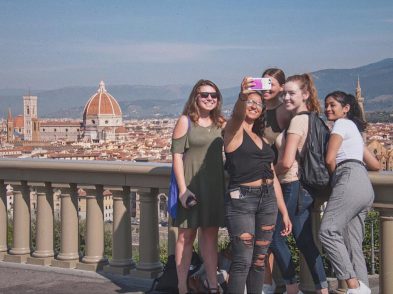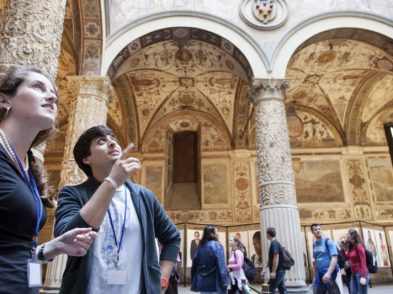The irony of my job is not lost on me. As I go
to work each day, I make my way on stony streets where it seems, at times, that
you can still hear the Guelfs and Ghibellines hurling abuses, and sometimes
even projectiles, at one another. From time to time, I duck as an actual piece
of rock comes down-falling masonry from a decaying palazzo. I arrive in the
modern building that houses the State Archive near piazza Beccaria, where the
staff in white lab coats has my materials ready for me (I placed my requests
online while sipping my coffee at home earlier that morning). Then I take these
400-year-old documents to my desk, where, along with the other members of the Medici
Archive Project team, I proceed to transcribe the handwritten words of members
of the Medici court on my computer. The documents are then placed online, where
they can be searched, commented upon and studied by people around the globe.
While admiring the glories of Florence’s
Medieval and Renaissance past, most people are completely unaware of the great
technological innovations taking place in the study of the city’s history. For
the past two decades, researchers like me, working out of the State Archive,
have been slowly and meticulously entering the contents of these centuries-old
letters according to a sophisticated data-entry process. Since the 1990s, we
have collectively entered 21,000 letters and created biographical profiles for
15,000 early modern people including duchesses and diplomats, goldsmiths,
soldiers, abbesses, and masons. This is, however, a drop in the bucket, for the
archival collection we are working on is immense; the Medici Granducal
collection (Mediceo del Principato),
gathered over the course of 200 years, encompasses 6,429 volumes of letters. We
have accomplished approximately one-tenth of our project; when we are done we
will have somewhere between four to five million letters online. No one really
knows exactly how many letters precisely, because until now no one has had the
means of systematically handling all of this vast information.
The work of Psyche, separating innumerable
grains of wheat? Or worse, that of Sisyphus rolling a stone endlessly up a
hill?
Astoundingly, the dream of completing this
undertaking within our lifetimes and bringing all of this precious material to
scholars and the public at large is at last becoming a reality. In October
2012, the Medici Archive Project, with the generous support of the Andrew W.
Mellon Foundation, will launch its new BIA digital interactive platform, which
will be available worldwide as an open source for similar research projects to
adopt. The name BIA was chosen because it means ‘force’ in ancient Greek, a
symbol of the power that digital humanities technology brings to this ambitious
scholarly undertaking. It is also, not incidentally, the name of one of Cosimo
I de’ Medici’s daughters and the subject of one of Agnolo Bronzino’s most
lovely portraits.
In addition to helping preserve the
irreplaceable documents in the State Archive, the images available on this new
system will promote research even in locations half a world away from Florence.
With BIA, anyone will be able to access extremely clear images of the original
archival documents. These can be navigated quickly and with ease because they
are streamed online. You can turn pages-every portion of the volume is
reproduced, including the covers and every single numbered folio-which can be
zoomed in on to enlarge a particular phrase, word or alphabetic letter and be
viewed in high magnification. What this means is that in addition to the
research team here in Florence, scholars worldwide will be able to enter data
on BIA. By increasing the number of researchers through this outsourcing, the
Medici Archive Project will be able to hasten the conclusion of this Herculean
task so that it can be finished in a period of years, rather than generations.
Furthermore, making use of social networking
functions, BIA will allow scholars to make annotations on the document records
and engage in dialogue with one another. As a scholar in Sydney, Australia
enters a transcription of a letter, another in Johannesburg, South Africa, may
enter a correction or comment on that letter. Scholars, who are accustomed to
working in a lonely void while carrying out their research, often waiting
months or years to present their work to the world and often much more time
before receiving meaningful input from their peers, will be involved in a
dynamic interchange with like-minded researchers throughout the world that
takes place in real-time. And in addition to these community comments, the BIA
platform will also provide various forums for users of the site to discuss a
wide variety of Medici-related topics, responding to one another in comment
threads.
Next time you are looking at the ancient remnant
of Florence’s city gate that stands isolated in the middle of the traffic
circle at piazza Beccaria, look over to your right at the modern State Archive
Building and think of the teams of researchers who are bringing the Medici to
life and online to a computer near you. Just as the Medici once stood at the
center of a world of Renaissance innovations, the Medici Archive Project is
reinventing the way scholarly research is conducted and making the documents of
the Tuscan Grand Dukes available to all the world.







